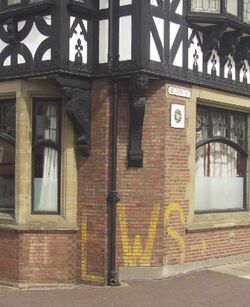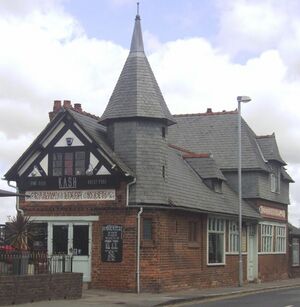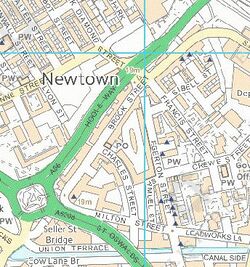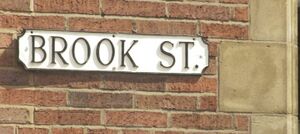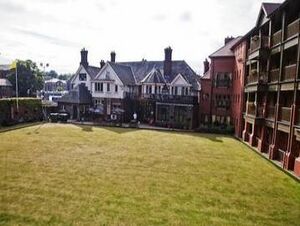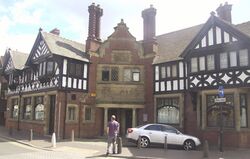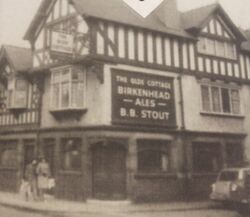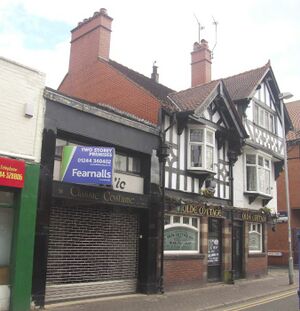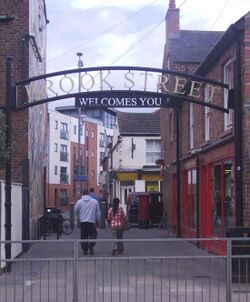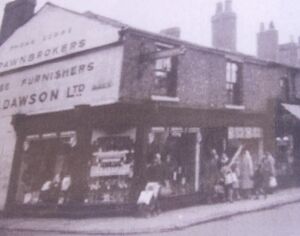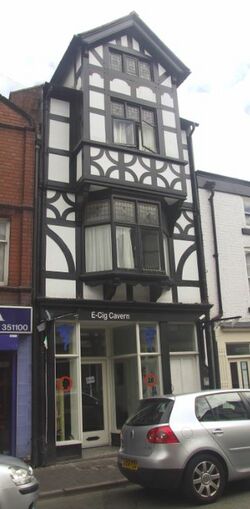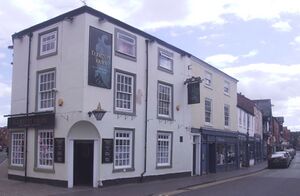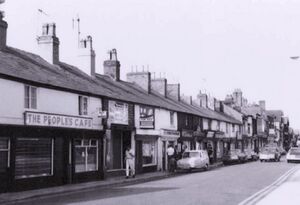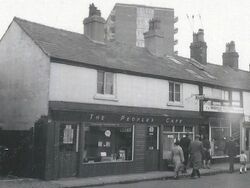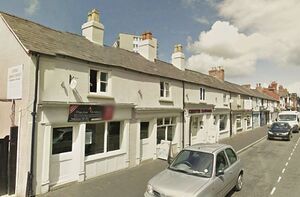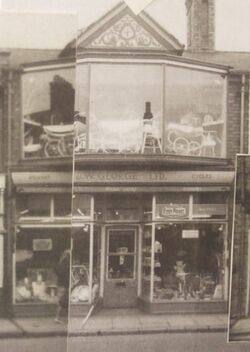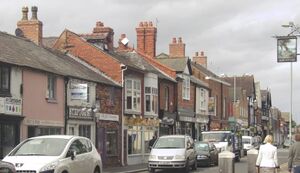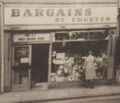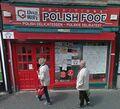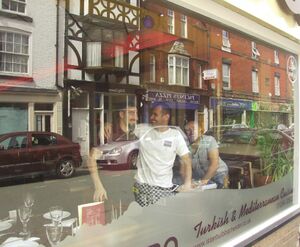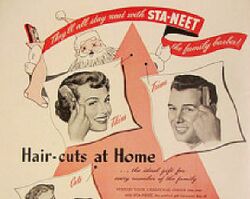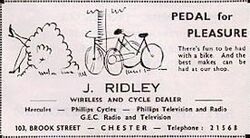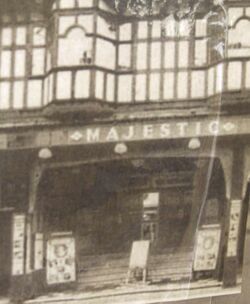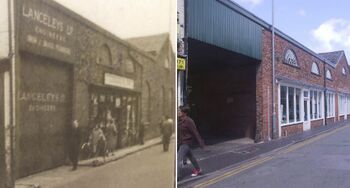Brook Street

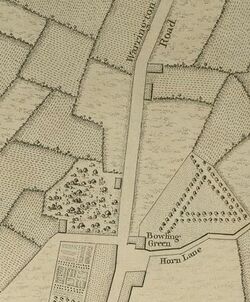
History
Brook Street developed along the principal route northwards out of the City to what is now Warrington thus linking the historic lowest crossing points of the River Dee and the Mersey. On leaving the City the street fell at a very gentle grade to the Flookersbrook, then a meandering stream flowing through marshy ground that separated the township of Hoole from the City. The street has a history of being cut through by new transport systems. This with the exception of the coming of the ring road had a beneficial impact on the economy of the street. In the 1770s the Chester Canal cut the upper end of the street where, until its rebuilding in the 1950s, Cow Lane Bridge acted as a pinch point separating Brook Street from Frodsham Street (Cow Lane). In the 1840s the lower part of the street was severed by the railway, the new Hoole Railway Bridge leaving a part of the street sometimes known as Lower Brook Street truncated by the railway station. The ring road severed the street just below the canal crossing at Cow Lane Bridge, the short length of Brook Street between the two now being known as Brookside. This upper part of the street adjoined The Gorse Stacks, an area that from medieval times had developed as the City's livestock market.
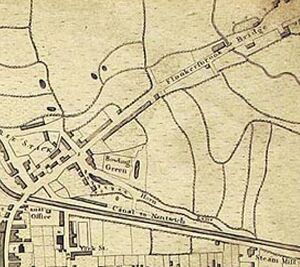
Today there is little evidence of buildings earlier than the mid 18th century. The outer ramparts of the Civil War siege defences lay in part at the southern end of the present street, and it is likely that any earlier buildings were destroyed during the siege. A bowling green has been located towards the upper end of Brook Street since Georgian times or earlier, although the most recent green now the site of an apartment complex appears to date from the rebuilding of the Old Bowling Green (now Catholic Social Club) in the early 20th century.
Map evidence provided by the Lavaux Map of 1745 shows that until the mid 18th century the street remained relatively undeveloped and comprised primary fields with limited numbers of buildings, which were concentrated towards the City end of the street. It is likely that many of these buildings were associated with the activities of the Gorse Stacks Market although even in this area much of the eastern side of the street was open to the Bowling Green and land known as the Justing Crofts, which separated the Kaleyards from the densely developed Foregate Street and Cow Lane.
Mutlow and StockdaIes Map of 1795 shows that by the last quarter of the 18th century the developed frontage of Brook Street had extended, on its western side to the junction with what was to become Brook Place and on the east side to what would become Egerton Street. Many of the late Georgian cottage rows such as numbers 39-61, 50-56, 72-82, appear to be associated with this era.
An 1825 Map shows that by this date all of the houses on the east side of Lower Brook Street have been built, whilst the western side of the street has been developed to the junction with Egerton Street. At this time it would appear that the street was principally residential in character. By this date Newtown has been named and was beginning to be laid out, although at this time it only extended for one block beyond George Street and the Cattle Market as Oulton, William and Thomas Streets. By this date also Charles, Milton and Egerton Street have been laid out but little of Francis Street. The increased pace and status of development along the street might be judged from Joseph Hemingway’s 1829 “Perambulation of Chester” in which he describes Brook Street as being "respectable" in appearance (as compared to "mean and miserable" Frodsham street):
- "The next opening presented by Foregate street is on the north side named Frodsham street formerly called Cow lane and still more remotely Coole's lane. It is one of the principal entrances into the city from Manchester Warrington and Frodsham the houses are generally of the meanest description the street narrow filthy and iuconvenient and but ill accords with the more distant approach at the beautiful hamlet of Flookersbrook and the respectable appearance of Brook street. This street has excellent capabilities of being widened and improved there being abundance of vacant ground behind particularly on the east side where the houses are most miserable but as the property has a great number of owners who are generally in humble circumstances there is no immediate prospect of any material improvement here."
Evidence of the more gentile character of the street at this time is provided by the late Georgian terraces 112-118, 120-124, 100-108 together with individual houses such as 71, 73/75.
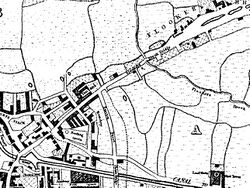
Wood’s Map of 1833 shows that Francis Street had been laid out although most of the streets on the east side of Brook Street were only developed towards the canal. By this time also, and before the arrival of the railway much of the settlement of Newtown had been laid out. The principal thoroughfare of St Anne Street had been laid-out and partially developed and the intervening streets between this and Brook and George Streets were now virtually fully developed. Beyond, at the heart of today’s Newtown, Cornwall, Gloucester and Trafford Streets had been laid out but were not yet developed. By 1838 the first Christ Church was to be built in this area. In 1847-48 Chester Station was built just beyond the northern end of Brook Street. The coming of the railway hastened the development already underway in the Egerton & Francis Street areas and Newtown.
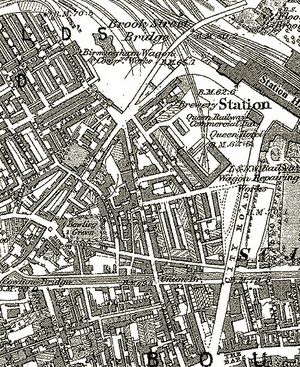
In Newtown small terraced houses were built without front or back gardens but after 1845 with individual yards and back access. Employment on the railways was undoubtedly part of the reason for the rapid development of the area, though the railway companies apparently did not themselves provide workers' housing. Further working-class terraces were built east of Brook Street, where development was restricted by the L.N.W.R. wagon repair works and the laying out of City Road in the early 1860s. The area between Egerton Street and City Road was covered with terraced housing by the early 1870s, after which it spread east of City Road on to the Leadworks garden, sold off for building in the 1890s.
Progressively the residential character of the area became mingled with industrial enterprises, at first these were located along the canal, examples including the pioneering steam powered corn mill of the 1700s and Walker and Maltbys Leadworks of 1800. By 1825 the extensive leather tannery, doubtless associated with the proximity of the cattle market had been established on the western side of the street and this partly survives today as retail premises 99-103 Brook Street: its surviving facade from 101 to 103A provides the only building of industrial character to the street frontage. Although of only one and a half storey, it has a rugged character with ton slate roofs, brick in English garden wall bond, and distinctive round-headed multi pane iron windows to the attic storey. Like other earlier buildings, these too have been adapted for retail use. In 1805 in nearby James Street, William Cole, Thomas Whittle and Johnson established the Flookersbrook Foundry (see: Industrial Revolution). In 1874 this became the nationally important Chester Hydraulic Company whose works came to occupy most of the large triangular plot of land between Brook and Egerton Streets. A measure of the industrial development of the area might be gained from White's Gazetteer, the entry for 1860 showing five engineering works and four foundries where at the turn of the century there had been none. The Egerton Iron and Brass Foundry, operated by James Mowle & Co. in 1871 and Mowle and Meacock by 1892, lay between Crewe Street and Albert Street, but had been demolished by 1910 when Egerton Street school was built on the site. The Providence Iron and Brass Foundry of H. Lanceley and Son, founded in George Street around 1869, moved later to a group of mostly single-storeyed buildings on the west side of Brook Street previously used by a tannery. Egerton Street Saw Mill was a threestoreyed range incorporating offices at the street end and works with an arcaded ground floor at the rear, probably built in the mid 19th century; by 1906 it was occupied by paint manufacturers.
At about this time the residential character of the street began to change as it developed a retail function servicing the adjoining areas of workers' housing. Many of the existing dwellings were adapted to this new function - the cottage rows, along with many of the higher status buildings acquiring shop fronts. Only in Lower Brook Street was the residential character maintained. New purpose-built shops were constructed during the late 19th and early 20th century, apparently replacing earlier buildings most likely to be similar to the late Georgian cottage ranges. At this time Brook Street followed the trend established in the principal streets of the City acquiring a variety of Tudor revival buildings. Some were associated with retail functions such as, 60, 84/86/83, others entertainment such as 95-97; the former Majestic Cinema. The best work of this type is undoubtedly provided by the local breweries, whose public houses provide key focal points at the entry to the street at both its northern and southern ends and at the junction with James Street. These buildings often feature graduated grey slate roofing with well detailed barge boarded gables, prominent and well detailed stacks, timber framing to the upper storeys, with ground floors in rustic brick. Windows are usually leaded metal casements, to the upper storey set in timber frames and on the ground floor in stone mullions and jambs. The best example of this treatment is the Old Bowling Green (now Catholic Social Club) listed at grade II, others include The Stanley, The Old Cottage, The former Railway and the former Railway Tavern (126). Seeking a different architectural style, the former Cocoa Rooms (121) provides a fine, but solitary, representative of the Arts and Crafts movement.
In 1840, before the construction of the General Station (1847-8) the area to the immediate west of the present station was occupied by two temporary stations, one for the Chester & Birkenhead Railway and the other for the Chester & Crewe Railway, Chester & Holyhead and Chester & Shrewsbury. Although consideration was given to relocating the General Station closer to the City Centre, it was decided to consolidate the operation about the existing track. In his Stranger's Guide of 1859 Thomas Hughes comments on the route from the station to the City by Brook Street saying that:
- "its many parts inconveniently narrow, abounding in sharp curves and unsightly proportions and certainly nowise equal to the continually increased traffic".
At the northern end of Brook Street lay extensive railway wagon works on both sides of Brook Street adjacent to the General station.
At the end of the 1960's the Inner Ring Road cut a (some say destructive) path through the city and the dual-carriageway of Hoole Way was built parallel to Brook Street. A part of the western side of Brook Street at the northern end was demolished in the process, and Brook Street went into something of a decline. The 1980s and 1990s brought further economic decline as much of the areas traditional employment base, including the Chester Hydraulic Company and The Railway Wagon Works closed. The area has suffered a long-term decline in business activity and population. rook Street contains over 70 shops, which offer a wide range of specialist products and is well known locally for its quality restaurant and take-away outlets. Whilst the location of these shops is in a good strategic position between the main pedestrian route from the Station to the core of the City Centre, trade for the specialist shops has declined significantly over the recent years. Retailers selling outdoor clothing, camping gear, comics, music and diving equipment all reported trading losses and a rapid turnover in retailer presence on the street started to be apparent. The City Council has for some time sought to gain external funding to assist in the regeneration of the area. In 1996 Brook Street was the subject of an unsuccessful bid for English Hertage CAPS (Conservation Area Partnership Schemes). However at the time ERDF monies were used to relay the pavements. Subsequently successful bids have been made to English Heritage for HERS (Heritage Economic Regeneration Scheme) and PSICA (Partnership Schemes in Conservation Areas). The HERS scheme has contributed to the repair and enhancement of many properties in Brook Street. After an initial slow rate of take up for grant there is now (2014) a considerable momentum amongst property owners to pursue schemes of grant aided heritage repairs and enhancements. The completed schemes have demonstrated good practice and show how well specified and executed repairs can bring about dramatic improvements in the visual appearance of the street.
By 2018 Brook Street had become home to a thriving multi-cultural community with a range of Eastern European and Asian grocers/bakers/butchers as well as many ethnic restaurants and eateries. It is thought by some to be the go-to place in Chester for inexpensive food, condiments and spices. Given that this page is always out of date because of the high business turnover, it is well worth visiting Brook Street now and then to see what is new.
Architecture
Although occasionaly rather neglected Brook Street is fronted by a great variety of buildings, many of which have some architectural and historic interest. Many of the buildings that front Brook Street are small-scale two storey terraces, likely to be late Georgian in origin. Examples include 45-61, 50-56, 72-82 and 105-111. Although originally thought to have been cottages, they have without exception converted to shops during Victorian times. These buildings are constructed of brick, although a number have been finished with a traditional stucco render (72-82) and now most of the buildings have painted walls. Roofs are of low pitch originally in slate with simple eaves details. Gutters are usually of iron to conventional section, although there are some examples of timber box guttering (50-56) exceptionally with a simple decorative motif carved into the boards. The stacks are simply constructed in brick but form an important element of the architectural composition, breaking the long continuous low roofline, distinguishing each component of the row and providing a bold feature that adds scale and verticality to the terraces. Window openings are small, typically they would have accommodated two element horizontal sliding sashes or side hung casements with simple subdivision of panes. Many have some surviving elements of simple but well executed shop fronts often partially concealed by later accretions. They feature simple timber pilasters, fascias and cornices entirely appropriate to the character and scale of the properties into which they have been inserted. Of similar age and style, there are several three-storey cottage pairs/terraces including 58/60 and 88/90. They have a lined stucco render, simple slate roofs with cast or timber box gutters, and simple horizontal sashes or casements. Like their companion two storey rows, they were also adapted for retail use in Victorian times. Interspersed with these buildings, and often located at prominent positions on street corners, are a variety of early 19th century dwellings of higher status. They feature slate roofs of low pitch, some with large "ton" slates. The eaves are formed of stone cornice gutters; some have surviving lead fall-pipes. Windows are more formal multipane vertical sliding sashes. Formal panelled entrance doorways with cases and fanlights survive at 76 and 94. Construction is of brick in Flemish bond as at 71 and 73/76 flanking Brook Place, or in lined stucco render as at 94/96 on the corner of Egerton Street. With the exception of 96, now the Egerton Arms, all have been adapted to retail use in Victorian times. In the case of 73/76 by infilling the garden frontage with a pair of Victorian shops, which retain many original features, including a prominent coved fascia.
East Side
Number 24-26
Ye Olde Bowling Green Hotel, later public house, now licensed club. The Catholic Social Club moved here from original premises in Queen Street. The building dates from 1913-14 and is by John Davies and Sons, originally for Greenall Whitley and Co. English garden wall bond red-brown brick with yellow sandstone dressings and timber frame with plaster panels; pebbledash; graded Westmorland green slate roof. A fine example of Chester's vernacular revival style with rear in domestic Queen Anne style. 2 storeys; two 3-window wings at right angles, one to Brook Street, the other to Milton Street deeply recessed to contain a corner entrance. Ground floor of brick dressed with yellow sandstone; mullioned and transomed leaded casements and canted bay windows to each wing; double part-glazed panelled oak doors in Roman Doric porch with entablature and upper storey of stone-dressed brick between 2 projecting plinthed chimneys with lozenge flues in an Elizabethan manner. The first floor has ornate small framing with jetties on herms and quadrant and curved herringbone braces; mullioned leaded casements and oriels; well-handled informally composed roofs. The rear is pebbledashed; a one-storey rear wing provides balcony to first floor with shaped splat balusters; small-pane windows standing proud of wall-face; 2 canted bays; modillion cornices and eaves; 5 plinthed chimneys with lozenge flues. This is the most substantial and well-composed example of John Davies's Vernacular Revival public houses in Chester. The bowling green behind was one of the oldest in Britain - having been in use since before 1745 - but, in 2001 it was partially destroyed when the Catholic Church sold the land for the erection of a development of retirement apartments. The remainder is however still occassionally used for bowls. A "Chester Guide" describes it as follows:
- "At the Bowling Green in Brookstreet the ground is kept in excellent order and there is every convenience and attention shown to those who may wish to spend an hour in this pleasing and healthy recreation. The green covers an area of one hundred and seventy-eight feet in length and one hundred and forty-eight feet in breadth and is well attended during the summer months"
On the wall, at the corner of Milton Street, the faded letters "EWS" can be seen in yellow paint. This dates from WW2 and indicates the location of an "Emergency Water Supply" Above the corner door, seldom noticed is a bas-relief of Francis Drake et al. playing bowls while the Spanish Armada looms in the distance (there is no known eyewitness account of this incident and the earliest retelling of it was printed 37 years later).
Number 28-32
A new-build of retirement appartments now occupies this site and the design is reasonably well integrated with the surroundings. Previously the site was occupied by the "Household Shop" and "W. Williamson" a motor car garage and petrol salesman, in a imposing three-storey brick building witth oriel windows on the second storey and jettied dormers on the third storey. The "ESSO" signs of a later "open plan" garage can be seen in some of the photographs below.
Number 34-36
The Olde Cottage Inn two and three storey to 34 and 36 respectively. Late 19th century. Ground floor frontage and principal elevation to James Street in narrow Ruabon brick with sandstone reveals to wall openings and stone cornice. First floor in painted rough cast to 36, to 34 in timber frame. Second floor to no 34 in timber frame mostly of close studding, jettied timber framed gables to street to both 34 & 36. Stacks in Ruabon brick, red clay tile roof of two transverse piles. Windows leaded casements and to second floor, mostly as oriels. Windows, set back to ground planted to first and flush to second floors. The original building on the site looked quite different and was a terraced "corner pub" before being given the "Chester Look".
Number 38
One-and-a-half/two storey, greatly modified two storey cottage range. Has had inter-war years Art Deco make-over with symmetrically arranged deeply recessed shop front in steel with "Vitrolite" stall riser and pilasters which rise to first floor window head. It would seem that as originally installed this would have risen to one and a half storeys to provide display window. Now modified with lower infill panel and narrow horizontal slit window above. Crude brick above corniced window head likely to have also featured a vitrolite fascia. Longitudinal roof of concrete tile, stacks lost.
"Vitrolite" was an opaque pigmented glass manufactured by Pilkington Brothers in the United Kingdom. Used for internal and external tiling and façades of buildings from the 1920s to the 1950s, it is often associated with the streamlining of the Art Deco and Art Moderne movements. Its polished, slick and shiny surface could be curved, textured, sculptured, cut, laminated, coloured and illuminated; it could also be readily retrofitted to existing buildings.
Number 40
Two storey house. 19th century plain painted brick frontage likely to have been rebuilt rising to shallow parapet coped with concrete. Longitudinal roof ridge concrete tile, stack to full height to north side.
Number 42-44
Two storey house likely to be of one build, early 19th century, painted brick with stone cornice gutter roof of ridged concrete tile, most stacks demolished one to full height with square terracotta pots at north end. Each unit has one upper floor window opening of sash proportions recessed with stone cills, flat brick head to 44, raised to timber lintel to 42.
Number 46
Early 19th century house likely to be single build with 42 and 44, painted brick with stone cornice gutter, flat concrete tile roof, longitudinal to Brook Street with hip above at junction with roof to rear wing fronting Charles Street. Windows of sash proportions, stone cills, flat timber lintels. Two over two recessed sashes in reveals to Brook Street elevation. Charles Street elevation has blocked up shop front opening of earlier shop front.
As can be seen from the old photograph below this building used to house a pawn-broker. In 2015 it still carried on a similar line of business. The pawnbroker's "three balls" have survived. In the west, pawnbroking existed in the Ancient Greek and Roman Empires. Most contemporary Western law on the subject (assumption of risk etc.) is derived from the Roman jurisprudence. As the empire spread its culture, pawnbroking went with it. Likewise, in the East, the business model existed in China 3000 years ago no different from today, through the ages strictly regulated by Imperial or other authorities. In spite of early Roman Catholic Church prohibitions against charging interest on loans, there is some evidence that the Franciscans were permitted to begin the practice as an aid to the poor. In 1338, Edward III pawned his jewels to raise money for his war with France. King Henry V did much the same in 1415. In 1603 an Act against Brokers was passed and remained on the statute-book until 1872. It was aimed at the many counterfeit brokers in London (a type of broker was evidently regarded as a fence for stolen goods). The pawnbrokers' symbol is three spheres suspended from a bar. The three sphere symbol is attributed to the Italian province of Lombardy, where pawn shop banking originated under the name of "Lombard banking". The three golden spheres were originally a symbol medieval Lombard merchants hung in front of their houses, possibly originally three flat yellow effigies of "byzants", or gold coins, laid heraldically upon a sable field, but converted into spheres to better attract attention.
Number 48
Post Office. Late 18th century cottage row. Highly altered elevation, painted Tyrolean type render. Longitudinal slate roof, timber box gutter. Stacks demolished, replaced three element Crittall steel window to Brook Street, and Charles Street where 2 over 2 sash remains. Shop frontage appears to have originally had splayed entrance on street corner now blocked.
Number 50
Cottage row late 18th century, possibly same build as 48 but with lower ridge. Painted textured render on brick, longitudinal slate roof, timber box gutter, stack lost.
Number 52
Fully renovated under HERs scheme. Late 18th century cottage row, likely to be contemporary with 50 and 54, stucco rendered over brick, longitudinal slate roof, reinstated stack, timber box gutter, recessed two over two sash with stone cill and segmented head. Restored traditional shop front.
Number 54
Fully renovated under HERs scheme. Late 18th century cottage row, likely same build as 52 and 50, stucco rendered brick, longitudinal slate roof, box gutter, stack, 8 over 8 flush sash beneath flat timber lintel, restored Victorian shop front.
Number 56-58
Fully renovated under HERs scheme. Three storey late 18th century house, stucco render over brick, longitudinal slate roof, decorative parapet gutter, reinstated stacks, flush 8 over 8 and four 8 sashes, reinstated Victorian shop front.
Number 60
Late 19th century in vernacular revival timber frame with transverse slate roof, retail premises with living accommodation above and work shops behind. Four storeys, narrow frontage in timber frame with much decorative bracing, windows leaded and plain casements, upper floors as oriels and jetties, reinstated recessed shop front.
Number 62
Three storey late 19th century retail premises with living accommodation over. Ruabon brick, elevational treatment in Flemish style with shaped gable, terminal and intermediate plain pilasters forming three recessed bays of brick work, transverse roof of concrete tile, 6 over 1 and 9 over 1 shallowly recessed sashes, first floor with central oriel window with hipped slate roof.
Number 64-70
Block of plain Edwardian retail units of single build with living accommodation above. Originally providing 4 retail units. Three storey in Ruabon brick with slate roof now replaced in concrete, stacks survive only to 68, plain frontage save for sandstone bands at each cill level. Sash proportioned windows openings now with upvc windows beneath sandstone heads, first floor having brick segmented relieving arches above. The block is called "Hamilton Buildings" according to an ornately lettered stone plaque set in the brickwork.
Number 72-82
Two storey late 19th to early 20th century cottage range likely one build to number 82. Two storey painted rendered brick, concrete longitudinal tile roof stack lost, single flush casement window, stone cill segmental head. 80-82 repaired and restored under HERs scheme, stucco render on brick, slate roof box gutters reinstated stacks, replica shop fronts, flush casement windows.
Number 84
Early 20th century retail unit with showroom above, two storey transverse roof of asbestos slate, street frontage gable in jettied timber frame with herringbone stud pattern. First floor fully glazed display window with large central oriel. Shop front appears to be inter war years with recessed central entrance formed in a Streamline Moderne style of curved glazing and "Vitrolite" stall risers. Other elevations in brick.
Number 86
Late 18th century town house. Three storey likely single build with 88, lined render, longitudinal slate roof, stacks demolished. The upper floor has 6 pane 2 element casement, first floor has Yorkshire horizontal sliding sash.
Number 88
Late 18th century town house. Three storeys likely single build with 86. Transverse slate roof, stacks demolished. Has an eaves dentil course which runs across both this prperty and 86., upper floor has 8 pane 2 element casement, first floor has Yorkshire horizontal sliding sash of 3 elements each divided by 2 into 3 horizontal elements, both have stone cills and segmental heads to first floor and flat head to second floors. Modern shop front. Extensively modified and restored.
Number 90-92
Late 18th century two storey cottage. Longitudinal slate roof, stacks demolished. First floor has 2 window openings of sash proportions with cills and segmental heads. Extensively altered building, tall parapet upstand suggesting possible original 3 storey building, although not of same build as 94 & 96 adjoining. Now has only two floors.
Number 94
Late 18th century town house, Three storeys and of 2 bays, stucco rendered, longitudinal slate roof, stacks demolished, stone cornice gutters, flush sashes, 4 over 4 to 2nd floor, 6 over 6 to 1st floor. Original 4 panel door, door case and fan light to street giving access to Egerton Arms, otherwise reproduction shop front.
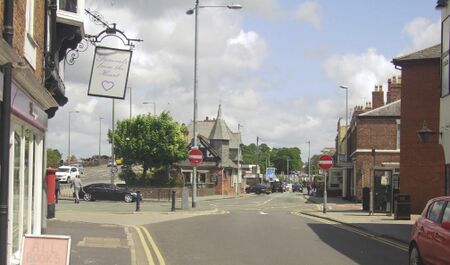
Number 96
Egerton Arms. 18th century town house, three storey of 2 bays possibly one build with 94 Brook Street. Two bay return to Egerton Street with splayed corner doorway. Longitudinal slate roof with hips, retained stack, stone cornice gutter, painted stucco render, run mouldings to window reveals. Cover 6 sashes to 1st floor, various plain and multipane transome lights to ground and 1st floors. Original splayed entrance at corner Brook and Egerton Streets.
Beyond Egerton Street
The northern end of the street is very different in character to the rest, retaining on the one side a domestic character that has been lost elsewhere, and on the other side (other than the "Arts and Crafts" Cocoa House, and a modern terrace of flat-roofed shop units. The eastern side of the street with the exception of the timber framed former "Railway Tavern" (also known as the "Ormonde") entirely comprises good quality 2-3 storey late Georgian terraces. These feature slate roofs – some retaining ton slates, prominent but simple brick stacks; parapets in stone 112-118 and 120-124 or stone cornice gutters 100-108. Walls are in good quality brown orange brick, in Flemish bond to the frontages. Window openings have segmental heads and stone cills and accommodate multi-pane vertical sliding sashes. The entrances are well detailed with panelled doors, cases and fanlights. Many of the less altered examples are listed at grade II, including 112-118 and 120-124.
Behind this part of Brook Street a surviving area of working houses is to be found on Sibell, Ormond, Chisham, Carter and Belgrave Streets. Carter and Belgrave Streets have retained their stone setted surfaces, which greatly enhance their character although the companion Yorkshire stone paving has now been lost. Although of differing dates of construction, the building type and character of the areas is very uniform comprising very plain terraced housing built hard to the street. Some of the earlier mid nineteenth century blocks of housing on both Sibell & Belgrave Streets have slightly more elaborate front doorways which sport cases, otherwise the treatments are extremely simple. The buildings on Ormond and Chisham Street and the western side of Sibell Street are Edwardian and in Ruabon brick. Elsewhere the later nineteenth century blocks are similarly plain but are of common brick.
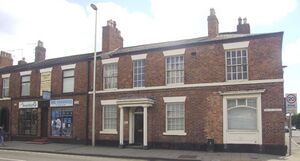
Number 100
Former Glynne Arms. Early 18th century town house, 2 storey, 4 bays to Brook Street, 1 bay to Francis Street, brick in Flemish bond longitudinal hipped slate roof, stone cornice gutter, stacks survive, stone band at cill level. 8 over 8 recessed sash to 1st floor with stone heads and cills, corner bays to ground floor have remains of public house windows with cornice plain pilasters and raised stallriser but original windows lost, ground floor sashes replaced with transome windows original door, door case, fanlight, and partially modified porch as columns survive. PISCA grant offered for repair and reinstatement of lost features. The ring seen below one of the ground floor windows was originally intended to secure the hatch of the "beer drop" in an open position.
Number 102-102A
Early 19th century townhouse likely single build 100 to 108, 2 storey, 3 bays, transverse slate roof. Stacks remain, stone cornice gutter. Flemish bond brick, 1st floor has 3 openings of sash proportions middle is blind others with replaced wooden transome windows, stone band at cill level. 1960s shopfronts served by central entrance.
Number 104
Private dwelling. Early 19th century townhouse, 2 storey, 3 bays roof of concrete tile, stacks remain, stone cornice gutter. Flemish bond, brick to walls replace upvc window in original sash proportioned openings, original doorcase and fanlight survive, replaced 6 panel timber door, replaced modern brick garden wall.
Number 106
Two storey 3 bay town house, slate roof, most stacks retained, details formerly as others in this range of buildings now rendered with large enclosed 1960s porch to central doorway. Sashes replaced with timber transome windows. Modern brick boundary wall.
Number 108
Similar to 106 re porch render, replacement windows and modern boundary wall. It retains a slate roof although the stacks have been lost.
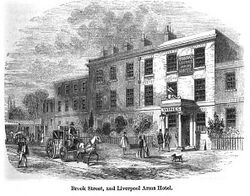
Number 110
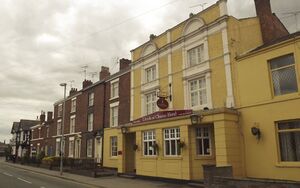
Former Liver Hotel, initially the "Hobday Liverpool Arms Hotel". Obtained a PISCA grant for repairs and restoration, part of 3 storey Georgian early 19th century terrace of town houses with frontage partly reworked in the Edwardian period of the early 20th century, by the younger Lockwood's. Two bay frontage longitudinal slate roof, most stacks retained. The ground floor has been formed into projecting bay with rusticated finish to render, 1st and 2nd floors in rough cast sub-divided into two principal bays by full height pilasters, window surrounds also formed by additional full height pilasters, with arched heads to parapet (these arches are a feature of the Edwardian re-work). Windows multipane casements to 1st and 2nd floors, single pane casements to ground floor.
Hughes is effusive about the Liverpool Arms and recommends this hotel as the place to stay in Chester (he was writing in 1858):
- "Leaving now the Station we see upon our left hand the lofty Shot Tower and Lead Works of Messrs Walker Parker and Co proprietors of a similar establishment near London Bridge while on the right our view is obstructed by the handsome and commodious Bridge which here stretches across the railway and connects the city with its suburb Flookersbrook. Those carpetbags and cloaks by the bye however useful they may be in their way are but superfluous companions for a jaunt about the city. Suppose then we drop in at the Liver a most respectable Hotel within hail of the Station and there depositing our luggage in one of the cosy bedrooms of that establishment we will sally forth on our mission. After one night's sojourn at this house you ll know your hotel we promise you for all future time. Wending our way into the city along Brook Street we come in due course to Cow lane Bridge erected in 1776 when the canal which flows beneath it was originally projected "
Number 112
Incorporated into Liver Hotel but retains most of original Georgian elevational treatments. Longitudinal slate roof, retained stack. Stone cornice with stone parapet. Flemish bond brick, ground floor rendered and original entrance blocked, 4 over 8 sash to 2nd floor, 8 over 8 sashes to 1st and ground floors, lead fallpipe and hopper. Part of one build from 110 to 118, stone upstand to railings survives replaced modern railings, paved forecourt.

Number 114
Annexe to Lloyds Guest House. Retains stacks and slate roof, stone cornice and parapet upstacks. Flemish bond brick work windows replaced with timber transoms, original doorcase remains, replaced door and fanlight, stone upstand for railings survives, paved forecourt.
Number 116
Private dwelling. Retains stacks, asbestos slate roof, stone cornice and parapet, upstand. Flemish bond brickwork, 8 over 8 recessed sashes original panelled door and fanlight, retains stone upstand for railings and stanchion for former gate.
Number 118
Annexe to Lloyds Guest House as 116 but has lost original door.
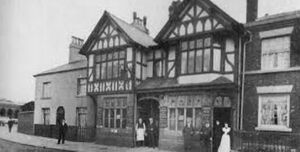
Number 120
One of three 2 storey late Georgian early 19th century terraces, 120 – 124. Slate roof, retained stacks, stone cornice and parapet upstand, Flemish bond, stone band at cill, stone cills and heads, recessed 8 over 8 sashes, semi circular door head in brick, original six paneldoor, stone upstand for railings lost.
Number 122
Similar to 120 but replaced door, and stone upstand for railings in place.
Number 124
Similar to 120 but windows replaced with timber transoms, replaced door, modern boundary wall.
Number 126
Former Railway Tavern public house, later renamed as the Ormonde tavern. Late 19th, early 20th century. Two storey, 3 bay semi symmetrical arrangement with projecting terminal end bays, timber framed gables to projecting bays. Slate roof, 1st floor timber framed. Ground floor Ruabon brick with stone dressings to window heads, cheeks and cills, casement windows with leaded transome lights.

This building is now the Ormonde Hotel. "Ormonde" (1883–1904) was an English Thoroughbred racehorse, an unbeaten Triple Crown winner, generally considered to be one of the greatest racehorses ever. He also won the Champion Stakes and the Hardwicke Stakes twice. At the time he was often labelled as the 'horse of the century'. Ormonde was trained at Kingsclere by John Porter for the 1st Duke of Westminster. His regular jockeys were Fred Archer (who features on the sign outside the hotel in the correct colours) and Tom Cannon. After retiring from racing he suffered fertility problems, but still sired Orme, who won the Eclipse Stakes twice.
It has been suggested that "Ormonde's" sire was the model for "Silver Blaze" in the Sherlock Holmes story of the same name, first published 1892. In the same way, "Colonel Ross" in the story is said to be based on one of the Grosvenors - the first Duke of Westminster. Eaton Stud bred many great names in racing notably "Sceptre", "Peregrine", and "Bend Or". The latter being the sire of "Ormonde". In 1880 the Epsom Derby was won by "Bend Or" and "Robert the Devil" was placed second however a few weeks after the running of the Derby an objection was made by the owners of "Robert the Devil": "on the ground that Bend Or was not the horse he was represented to be, either in the entry or at the time of the race." A groom suggested that "Bend Or" (ridden to a win by Fred Archer) had been replaced by a disguised "Tadcaster" (also from the Eaton Stud). Bearing in mind that the groom, one Richard Arnull, had been fired by Westminster and was working out his notice when he made the allegation, it might have been construed as a mischievous, even malicious, attempt to embarrass his employer. After much publiciry the claim was dismissed by the Jockey Club, although the groom maintained that a substitution had occurred for the rest of his life - as did his two sons, who also worked at Eaton. Like "Silver Blaze", "Bend Or" was marked with a distinctive white "blaze" on his face. In the Holmes story the horse is disguised by covering this blaze, and after Holmes solves the mystery wins a race still disguised. Research by Mim Bower of Cambridge University (Institute for Archaeological Research), first published in 2012, compared DNA of "Bend Or" (his skeleton was preserved at the Natural History Museum) to that of "Tadcaster" descendants. Both chesnut colts were by the stallion Doncaster but "Bend Or" was out of "Rouge Rose" and "Tadcaster" was out of "Clemence". And the DNA results show that the 1880 Derby winner was out of "Clemence" making the winner not ""Bend Or" but "Tadcaster". The two had indeed been switched, either as foals or later - the skeleton known as "Bend Or" is most probably that of "Tadcaster". So the Conan-Doyle story "Silver Blaze" seems to be based on a suitably Sherlockian mystery that really occured.
- Silver Blaze;
- The Mystery of Bend Or;
- TRUTH IN THE BONES: RESOLVING THE IDENTITY OF THE FOUNDING ELITE THOROUGHBRED RACEHORSES;
- Who won the Derby?;
- More discussion of this building at Chester Memories;
Number 128
Much altered 3 bay two storey town house early 19th century, modern rendered finishes sashes replaced, modern shop front to 1½ bays, slate roof retains stacks. This was originally the station-masters house - "Brook Cottage" (for Flookersbrook), which is where Thomas Brassey lived when he built Chester Station.
West Side
Number 37-39
Stanley Arms, built in 1925.
Number 41-43
Set of former cottages in cottage row extending to 61, and likely to be late Georgian in origin. The cottages share a longitudinal slate roof. This example has rendered stacks retains, and stuccoed render to brick. The original window openings on the upper floor have two element replaced modern casement windows. The "People's Cafe" which stood on this site (see older photo) had a famous "hole in the wall" where, in the late 1970's it was possible (perhaps only for the desparate) to purchase a fairly basic "burger" or soup very late at night (until after 03:00hrs, according to some accounts). The shop-front has been carefully restored to provide a good facimile of its possible Victorian appearance.
Number 45
Substantial elements of simple Victorian shop front survive on this building, including cornice fascia and fluted pilasters. However comparison with previous photographic evidence reveals that much of the frontage is reconstruction, including the upstairs window. In a previous incarnation this was a television shop and had a set-back shop frontage with a "mock-Tudor" upper storey and copious ariels and antennae attached to the stack.
Number 47
Similar to others in row, with slate roof. The stack survives and has square terracotta pots. The front is painted brick, and a modified upper window opening now with timber transome window. Shop front very much altered, although simple block pilasters appear original.
Number 49
Similar to others in row, slate roof stack survives, painted brick walls. On the upper floor the original window opening with cill survives but now has a shallower modern window. The original Victorian shop front survives, virtually intact including cornice fascia, block pilasters and panelled stall.
Number 51
Slate roof, stack lost, painted brick walls, window modified similar to 49. The modern shop front in blue timber of fair quality is generally respectful of size and proportions typical of these buildings.
Number 53
Similar to others in row, slate roof truncated stack, textured render. The upper window has been widened to accommodate three element timber casement, although bekow this substantial elements of a simple Victorian shop front survive, including fluted pilasters and cornice fascia.
Number 55
Slate roof, stack lost, painted brick wall. The original upper window opening with splayed brick cills, survives but with a modern casement. The original simple Victorian shop front survives including cornice fascia, pilasters and shop front frame. This was, for many years the "Lolipop Shop", owned by David and Anita Rose and fondly remembered by many who grew up in Chester.
Number 57
Slate roof, stack lost, heavily textured render. Upstairs is an original window opening with stone cill, but a modern two element casement. The modern shop front is an ad-hoc assembly of timber, but cut off pilasters remain.
Number 59
Similar to others in row – slate roof stack survives, with square terracotta pots. Original window opening widened to accommodate 3 element transome window, only pilaster survives to Victorian shop front.
Number 61
Similar to others in row. Slate roof, front elevation rebuilt in brick with two-element modern eyebrow headed casements. Shop front new and attempts to replicate very simple shop front with short pilasters and fascia.
Number 63
Late Victorian/Edwardian retail premises with living accommodation/showroom over. Two storey, with two long bays longitudinal and a slate roof with half hexagonal hipped roof to projecting bay, likely later dormer. The stack is present. The Ruabon brick, first floor has two oriel windows with transomed casements. The Spice Balti was the second "Indian" restaurant in Brook Street and is one of the more authentic ones in terms of taste.
Number 65
A plain late Victorian two storey single bay shop with living unit over contructed in Ruabon brickr. The slate roof has retained its stack. The upper storey has a 2 over 1 sash. The shop front with recessed entrance retains original consol brackets, box and blind and fascia, all else is 1960s tile and timber.
Number 67-69
Two storey late Victorian or Edwardian buildings, one of pair of buildings but with differing elevational treatments. Longitudinal slate roof to both. 67 has a projecting gable to part of elevation. The stack has been retained with its dentil and arch detail. The front elevation of 67 is in Ruabon brick and 69 in smooth render but originally in roughcast. Until recently number 67 had a huge fully glazed oriel window which extended across the whole first-floor frontage, although it is likely that the original arrangement was for a smaller oriel beneath gable. By 2015 the huge oriel had been replaced by much smaller sash windows in a brick surround. The gable itself has pargetted plaster relief scroll work. No 69 has plain 1st floor treatment comprising modern, 2 element timber sash windows replacing original fenestration. No 67 retain its original shop front virtually intact, asymmetrical recessed frontage with transome lights, pilaster and coved fascia. No 69 has recessed shop front with central entrance, and most of the original shop front appears to survive.

A Gallery of Brook Street Images - old and new (2015)
Number 71
Early 19th century town house. Two storey 2 bay, slate roof, stacks lost, stone cornice gutter, brick window openings of sash proportions with modern sash windows. This building, with its corner setting, has a sympathetically restored shop front almost in an American "Diner" style, however the cornice appears to be from the earlier Victorian shop front. This was previously a motorcycle shop and some time prior to that a branch of the Chester Co-operative Society. Many consider the best place in Chester for a £5.00 "All day breakfast" which is the "Full English" with no shortcuts. Probably the nearest thing to "Nighthawks" (1942) by Eddie Hopper in Chester.
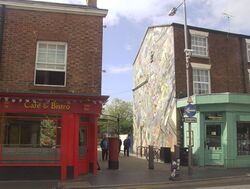
Number 73-75
Pair of early 19th century Georgian style town houses: three storey, 2 bays, with a longitudinal roof of flat concrete tile to 73 and ton slates to 75. All stacks have been lost. There is a stone cornice gutter, and brick walls in Flemish bond, with a lead hopper and fallpipe. 73 retains sashes, while in 75 these have been replaced with upvc windows. However 75 retains the original ground floor doorcase and fanlight, with a replaced door. A pair of flat-roofed Victorian shop fronts have been added as forward projection from building line, in wgat would have been the front garden. Both have substantial original elements surviving including shallow fascia, coving, pilasters. Number 73 retains, original door and a panelled original stallriser. The stallriser at 75 is modern tile. The alley wall of 73 is covered with the "Brook Street Mural" (see below).
Number 77-81
Modern build, replacing an earlier 1960's building. This site was previously occupied by a Georgian brick building which had a very incongruous "1960's" extension build forward of the building line. It included the premises of a well-known local hairdresser "IRENE".
Number 85
Repaired and enhanced with HERs grant. This is a late Victorian/Edwardian timber framed three storey structure with a transverse roof of clay tile. It has irregular square framing, with a herringbone to top of the gable, and sash windows.
Number 87
1½ storey late 19th century retail unit, low pitched longitudinal roof, tall narrow dormer, render finish, 2 over 2 sash, modern shop front. In earlier days this was a branch of "BOOTS" the dispensing chemist.
Number 89-93
Three storey late 19th century retail units with living accommodation above, transverse slate roof, rendered 2nd floor and gable with moulded stone copings and panelled terminal piers. Ruabon brick to 1st floor, 2 over 2 recessed sashes with stone heads and cills. Repaired with LOTS grant.
Previously this was a general hardware store "BARGAINS of Chester" with an elderly shopkeeper, named Tommy Edwards. The gentleman in question had started life as a chimney sweep, but "accidentally" got into the mail order-business when the realised that he could market a hair trimmer at low cost. His business expanded rapidly until it employed over a hundred people and could afford full-page advertising in national newspapers. Unfortunately, he was not very good at financial management and got into cash-flow problems which led to a bankruptcy. He ran the "junk" shop on Brook Street until his death, in his shop, in the 1990's.
Number 95
Repaired and restored using LOTS & HERs grant. Two storey timber framed frontage, remainder brick. This was the location of the early 20th century "MAGESTIC" cinema. The building has a double pile transverse roof with jettied coved timber framed gables to street, with square frame with herringbone/diamond bracing. The first floor has close stud box framing with both bays having splayed oriel windows.
The cinema was opened as "The New Cinema Deluxe"(owned by Pat Collins) in 1921 by Lady Arthur Grosvenor (Violet Cripps), re-opening as the "Majestic" in 1921. The first "talkie" was shown in 1930. It closed as a cinema in 1956. The 106 foot long, 1160 seat auditorium of the old Majestic was demolished when the Hoole Way section of Chester's Inner Ring Road was constructed in the late 1960's.
- more on the Majestic by Steve Howe;
- even more: by Paul Crofts from CHESTER CINEMAS;
Number 97-103
Much restored 1½ storey mid 19th century industrial building which was originally a leather tannery, then an engineering works (Henry Lanceley, Son & Co.). It is now now retail, and forms one building. It has a longitudinal and transverse roof of ton slate, and is of unpainted brick. The multipane half round cast iron windows beneath brick heads with brick cills have been fully restored. The building has a restored complete simple late Victorian/Edwardian shop front with new frame and panels inserted but retaining pilasters, consol brackets and cornice.
Henry Lanceley, Son & Co. was typical of engineering firms in Chester. It grew modestly in the late 19th century by exploiting opportunities in the region. Founded c. 1869, the firm started in a small way in George Street but after a move to larger premises in the same street, in the mid 1880s it took over a former tannery in Brook Street and converted it into the Providence Foundry and Engineering Works. In 1881 Lanceleys' business was largely concerned with satisfying the jobbing engineering requirements of other Chester enterprises, but it dealt with an extremely wide range of customers, and activities ranged from repairing mangles to supplying complete steam engines and boilers. By 1909 the volume of business had almost doubled and about half was from outside the city. In the 1900s Lanceleys benefited from the growth of John Summers's steelworks at Shotton and the sheet metal industry at Ellesmere Port, but the firm also carried out contracts along the north Wales coast, in the north-east Wales coalfield, and in the rural areas south-east and east of Chester. Even so, with a turnover of under £10,000 in 1908-9, it was a relatively small enterprise. However is was involved in what was at least an attempt to bring the advantages of steam-power to the Cathedral Organ.
Lanceleys also built at least one locomotive, which they took, by road to the the railway:
- "A CHESTER-BUILT RAILWAY ENGINE — About 60 years ago the first and only railway engine to built in Chester left the assembling yard on the premises of the firm of Lanceleys. Ltd. engineers, of Brook-street, and went along George-street and Brook-street to join the main railway line. It was driven by its own steam says Mr Thomas George Jackson, of 27. Clarenden-road Wallasey. whose father the late George T. Jackson was employed bv Mr Henry Lanceley the founder of the firm of Lanceleys Ltd." (Cheshire Observer, 3 January 1942)
Part of the premises seems to have ben occupied by "J. Ridley" who sold both push-bikes and "wireless" equipment, and had a "saucy" line of advertising which seemed to promise a bike was a guaranteed "ride".
Number 105
Two storey late 19th early 20th century retail unit with accommodation above. Ruabon brick, transverse slate roof gable parapet steps out with splayed brick, 2 windows to 2nd floor replaced with upvc until recently 2 over 2 sashes, shop front remains virtually intact although altered glazing.
Number 107
One of short cottage row with 109 & 111. Two storey late 18th early 19th century, longitudinal slate roof, stacks demolished, stucco render enlarged window opening with 3 element steel window now replaced in upvc, shop front ad hoc assemblage of bits – frame now replaced in upvc, fascia may be retained behind new signage.
Number 109
Cottage row late 18th early 19th century slate roof, truncated stack, stucco lined render, enlarged window opening with upvc window, retain substantial elements of simple Victorian shop front with recessed doorway, including cornice, pilasters and door.
Number 111
Repaired using HERs grant, reroofed, stack rebuilt, new windows, original shop front repaired and lost elements replaced.
Number 113-115
Pair of early 19th century town houses, 2 storey transverse slate roof, truncated stacks, brick upper floor windows of sash proportion but replaced with modern timber casements. Stone cills and brick flat arches, modern heritage shop fronts of reasonable design
Number 119
Former Railway Inn. Late 19th early 20th century timber frame public house. Complex roof geometry including jettied gables to splay of road junction and on return to Hoole Way junction, graduated Westmorland slate roof stacks with oversailing courses retained. Varied timber frame styles to 1st floor, ground floor brick with stone dressings to window opening. Ground floor windows leaded casements in timber frames set back in reveals, and to 1st floor, planted wooden frames with metal casements.
Number 121
Former "Railway Cocoa Rooms", dated 1880 on the end-window lintel, was repaired and enhanced with HERs grant. This is a high quality building in the Arts & Crafts style (there is another building in this style, a former rectory in Sibell Street). Second storey at north end single storey to south terminating in octagonal turret (containg spiral stair to a small upper room). The roof was previously in purple slate but this has been replaced with green Penrhyn slate. Second storey element has half dormers for upper floor windows, single storey element terminates in timber framed gable to Hoole Way junction with a small upper room. Second storey has slate hung first floor, elsewhere brick. Ground floor to Brook Street is partly in timber frame with herringbone brick noggin. Windows are multipane iron casements in timber frames. Stacks survive. Well detailed with oversailing.
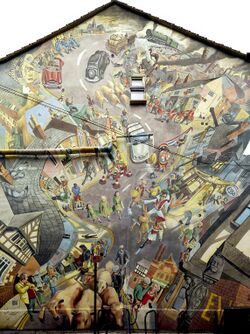
It is decorated with a pargetted panel to Brook Street and a "Sgraffito" panel to Hoole Way junction: both bear the name of establishment - "Railway Cocoa House" on the latter and "Chester Cocoa House Compy (Limited)" on the former. There are decorative motifs to Hoole Way of Cocoa plants to Brook Street of cormorants ("liver birds") and cherubs. Examples of graphic work on facades saw a resurgence circa 1890 through 1915, in the context of the rise of the Arts and Crafts Movement. The term "Arts and Crafts Movement" was first used by T. J. Cobden-Sanderson at a meeting of the Arts and Crafts Exhibition Society in 1887, although the principles and style on which it was based had been developing in England for at least twenty years. It was inspired by the writings of the architect Augustus Pugin (1812–1852), the writer John Ruskin (1819–1900) and the artist William Morris (1834–1896). As this building is dated 1880, it is a very early example of the style.
For many years after it ceased to be the "Railway Cocoa Rooms" this was the home of "City Strippers" a firm specialising in restoring pine goods (doors and furniture), for a while it was an excellent Greek restaurant, then an even better Italian restaurant, and in 2015 it is a bar supplied by a microbrewery.
"Brook Street Capers" Mural
Chester Renaissance, in collaboration with Cheshire West and Chester Council, advertised the public art commission for the wall at 73 Brook Street, Chester. The artwork celebrates the interesting history of the street and wider area. A fantastic response from artists from all over the country was received. Eighty-five interested artists registered on the procurement website the Chest, and 35 of them submitted interesting and exciting ideas and proposals. A shortlist of submissions was made by the Project Team, with representations from the local community in Brook Street and from Chester University. The short listed artists were from London, Chester, Wrexham, Warrington, Manchester and Yorkshire. After having invited the short listed artists to further explain and expand on their ideas, Gary Drostle was selected. His "exciting proposal" for this particular location was considered to be most fitting. Completed in the summer of 2011, the Brook Street street-scene is animated with references to events from the past, including the ‘cow parade’ during which cattle were driven through Brook Street from the railway station to the cattle market (Gorse Stacks), and across Cow Lane Bridge to the slaughter house. The mural was unveiled on the 8th August 2011.

Brook Street retains it's edgy status - drug deals can be seen ongoing during the day and while using this route into the City you might hear "Answer the door, or I'll kick the f***ing thing through" bawled out from the street as a cheaper alternative to a text message.
connect
sources and links
Related Pages
Online
- Vanished Pubs of Chester on Brook Street;
- Brook Street Carnival on Facebook;
- Shopping on Brook Street by Chestertourist (may be out of date - Brook Street has a very high turnover);
- Frodsham Street - Brook Street on the excellent "Chester Memories";
- A memoir of Brook Street;
- History Lessons;

